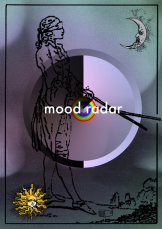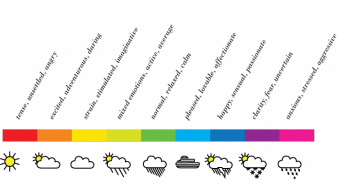User:Amy Suo Wu/Mood Radar overview
Mood Radar
Description
350 words including aims of the theoretical and practical research as well as its outcome.
Media
Photos
Video
Audio
Essay
approx. 100 word abstract
This paper is the theoretical complement to the practical component of a larger body of research on the role of prediction. The practical application of this thesis is an alternative weather forecasting system that predicts the weather based on measuring mood. The overarching objective is to question discourse regimes and how they shape reality through the management and construction of acceptable knowledge. Para-rationalism is explored as a method to simultaneously problematise and straddle the rational/irrational dichotomy in an attempt to transcend it. Divination can be seen as an example of para-rationalism and is addressed through the notions of paradox, synchronicity, truth as a model and self-fulfilling prophecies. Divination's legacy is traced in predictive algorithms in modern secular society seizing it's utility for surveillance and market driven incentives in the name of progress.
List of References
Books:
Boia, L (2005) 'The Weather Imagination', London: Reaktion books.
Franz, M-L v. (1980) 'On Divination and Synchronicity : The Psychology of Meaningful Chance Studies in Jungian Psychology', Toronto: Inner City Books.
Hall, S (1997) 'Representation: cultural representations and signifying practices', London: SAGE Publication Ltd.
Hofstadter, D (2007) 'I am a Strange Loop', New York: Basic Books.
Perkins, M (2001) 'The Reform of Time. Magic and Modernity', London: Pluto Press.
Perkins, M (1996) 'Visions of the Future. Almanacs, Time and Cultural Change, 1775-1870', Oxford: Oxford University Press.
Wiener, N (1966) 'God and Golem, Inc. A Comment on Certain Points where Cybernetics Impinges on Religion', Massachusetts: The M.I.T Press.
Articles:
Gladwell, M (2006) 'The formula. What if you built a machine to predict hit movies?' Online article available at: http://www.newyorker.com/archive/2006/10/16/061016fa_fact6
Hollinger, V (2006) 'Stories about the Future: From Patterns of Expectation to Pattern Recognition' in Science Fiction Studies, Vol. 33, No. 3 (pp. 452-472). SF-TH Inc.
Holmes, B (2007) 'Future Map.' Online article available at: http://brianholmes.wordpress.com/2007/09/09/future-map/
Latour, B (2004) 'Why Has Critique Run Out of Steam? From Matters of Fact to Matters of Concern', in Critical Inquiry, Vol. 30, No. 2. (pp. 225-248). University of Chicago. Online article available at: http://mendota.english.wisc.edu/~clc/Latour.pdf
Marsching, J.D (2003) 'Orbs, Blobs, and Glows: Astronauts, UFOs, and Photography' in Art Journal, Vol. 62, No. 3 (pp. 56-65) New York: College Art Association
May, S (2003) 'Meteorologica.' London: Tate Publishing. Online article available at: http://www.olafureliasson.net/publications/download_texts/Meterologica.pdf
Pizarro, D (2011) 'Everyday Apophenia.' Online article available at: http://www.edge.org/responses/what-scientific-concept-would-improve-everybodys-cognitive-toolkit
Shanken, E (2010) 'Knowing Art, Transcending Science.' Online article available at: www.artexetra.files.wordpress.com/2009/02/shanken_knowing_art_transcending_science_2010.pdf
Tedlock. B (2001) 'Divination as a Way of Knowing: Embodiment, Visualisation, Narrative, and Interpretation' in Folklore, Vol. 112, No. 2 ( pp. 189-197). Taylor and Francis, Ltd
Lectures:
Cramer, F. (2006) 'Tangent Conspiracies'. Online video available at: http://www.youtube.com/watch?v=TjbI8AQi3uA
Slavin, K (2011) 'How algorithms shape our world.' Online video available at: http://www.ted.com/talks/kevin_slavin_how_algorithms_shape_our_world.html?c=289257
link to PDF (PDF must be uploaded to wiki).
Additional Information
non optional
- One page itemised budget estimate


